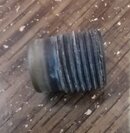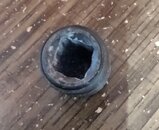You are using an out of date browser. It may not display this or other websites correctly.
You should upgrade or use an alternative browser.
You should upgrade or use an alternative browser.
Genesis valve hp seat
- Thread starter raftingtigger
- Start date
Please register or login
Welcome to ScubaBoard, the world's largest scuba diving community. Registration is not required to read the forums, but we encourage you to join. Joining has its benefits and enables you to participate in the discussions.
Benefits of registering include
- Ability to post and comment on topics and discussions.
- A Free photo gallery to share your dive photos with the world.
- You can make this box go away
Tanks A Lot
Contributor
This is the seat of an MDE (Midland Diving Equipment) valve.
I'm not entirely sure of the interconnections, but I believe the parts are now manufactured by the Cavagna Group or MDE got to be part of the Cavagna Group. Take this with a grain of salt!
That being said, MDE does not sell the seat (L100002) separately. They do sell the kit (HSDK), which contains all O-Rings, the seat, the stem and packing nut.
I have seen local divers in Africa remove the soft part of the seat and fill it with a molten polymer. I can't recommend doing so, for the following reasons:
I'm not entirely sure of the interconnections, but I believe the parts are now manufactured by the Cavagna Group or MDE got to be part of the Cavagna Group. Take this with a grain of salt!
That being said, MDE does not sell the seat (L100002) separately. They do sell the kit (HSDK), which contains all O-Rings, the seat, the stem and packing nut.
I have seen local divers in Africa remove the soft part of the seat and fill it with a molten polymer. I can't recommend doing so, for the following reasons:
- MDE changed the seat. What you have is still the old style, where that middle bit poking out of the "plastic" surface is also made of "plastic". This pin could under heavy use get really long and break off. That broken off piece could then lodge itself somewhere in the air path. Hence MDE changed the style to a design with the middle rod machined directly from the blank. The "plastic" was then poured around the rod.
- A flat seat with a molten polymer could work itself lose from the seat carrier. This would result in an obstructed air path, cutting the air off in an instant.
Thanks, sounds like doing that is not something I want to risk. It also turns out I only have ONE Genesis valve.This is the seat of an MDE (Midland Diving Equipment) valve.
I'm not entirely sure of the interconnections, but I believe the parts are now manufactured by the Cavagna Group or MDE got to be part of the Cavagna Group. Take this with a grain of salt!
That being said, MDE does not sell the seat (L100002) separately. They do sell the kit (HSDK), which contains all O-Rings, the seat, the stem and packing nut.
I have seen local divers in Africa remove the soft part of the seat and fill it with a molten polymer. I can't recommend doing so, for the following reasons:
I have seen both of the above happen. The locals I have seen do this did it only out of necessity.
- MDE changed the seat. What you have is still the old style, where that middle bit poking out of the "plastic" surface is also made of "plastic". This pin could under heavy use get really long and break off. That broken off piece could then lodge itself somewhere in air path. Hence MDE changed the style to a design with the middle rod machined directly from the blank. The "plastic" was then poured around the rod.
- A flat seat with a molten polymer could work itself lose from the seat carrier. This would result in an obstructed air path, cutting the air off in an instant.
axxel57
Contributor
No way for you to order the CV45 seat with a Sherwood/Genesis Representative?
Just received mine, but they are DP 8,01 US$ each now plus shipping.
If you have no joy finding one, you can PM me if you want, but I'm here in Europe.
Just received mine, but they are DP 8,01 US$ each now plus shipping.
If you have no joy finding one, you can PM me if you want, but I'm here in Europe.
Johnoly
Contributor
- Messages
- 4,703
- Reaction score
- 6,837
- # of dives
- 2500 - 4999
I'm just curious on valve internals,, If that broken off piece and blocked air path happened on a "full" tank, would you be forced to scrap the entire tank ($$) because the valve would be impossible to remove? Or could you tiny drill the burst disk/other area to drain the tank and unscrew the valve?That broken off piece could then lodge itself somewhere in the air path..........This would result in an obstructed air path, cutting the air off in an instant.
Tanks A Lot
Contributor
The couple of times I have seen it happen it never blocked the valve fully. It blocked it enough to give the diver trouble at depth.
If a valve is completely blocked, you either have to drill into it, or remove the burst disc if it has one. Incidentally the only time I was happy to see a burst disc on a valve...
I did drill a couple of blocked valves. The process is most unpleasant. Thick gloves, thick jacket, face-shield, protective goggles, ear muffs, etc. are all necessary. You aim as low into the air-path as you reasonably can - Think about the continuation of the dip tube, that's what you are aiming for. The hole gets drilled with a tiny drill, like 1.5mm. Once you get "through", the metal shavings from drilling usually fly back and lodge themselves somewhere in the face-shield or jacket.

If a valve is completely blocked, you either have to drill into it, or remove the burst disc if it has one. Incidentally the only time I was happy to see a burst disc on a valve...
I did drill a couple of blocked valves. The process is most unpleasant. Thick gloves, thick jacket, face-shield, protective goggles, ear muffs, etc. are all necessary. You aim as low into the air-path as you reasonably can - Think about the continuation of the dip tube, that's what you are aiming for. The hole gets drilled with a tiny drill, like 1.5mm. Once you get "through", the metal shavings from drilling usually fly back and lodge themselves somewhere in the face-shield or jacket.
- Messages
- 8,602
- Reaction score
- 7,310
- # of dives
- 2500 - 4999
For those valves I punch a bigger diameter plug out of nylon cutting boards tap it in screw it in to compress
then run sharp blade across the face
no separating nor blocking anything
then run sharp blade across the face
no separating nor blocking anything
- Messages
- 14,189
- Reaction score
- 11,447
- Location
- Port Orchard, Washington State
- # of dives
- 1000 - 2499
No need to drill out any burst disks, just loosen it a 1/4 to 1/2 turn and it'll leak down the tank. Do not remove it or drill it lest you turn the disk or the plug holding it into a missile.I'm just curious on valve internals,, If that broken off piece and blocked air path happened on a "full" tank, would you be forced to scrap the entire tank ($$) because the valve would be impossible to remove? Or could you tiny drill the burst disk/other area to drain the tank and unscrew the valve?
Similar threads
- Replies
- 2
- Views
- 396
- Replies
- 19
- Views
- 1,101
- Replies
- 12
- Views
- 979
- Replies
- 8
- Views
- 743






